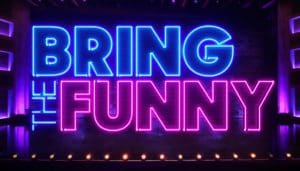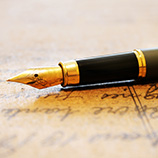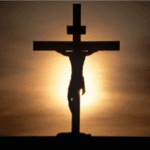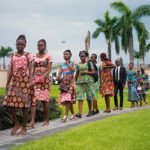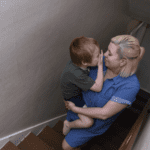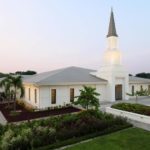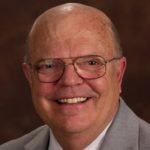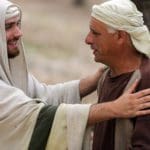Note: All images can be clicked to enlarge.
On an overcast, softly raining day, President Monson added the last item to a time capsule, which was then sealed and placed in the wall of the new Church History Library on North Temple, across the street from the Church Office Building.

The media were invited to come and take pictures at 9:15am on March 25, 2009, then the ceremony began at 10am. Afterwards, several members of the Church History department were available to answer questions, including Elder Marlin Jensen, Assistant Church Historian Richard E. Turley, Church History Department Managing Director Steven Olsen and Senior Conservator Chris McAfee. Most of the local television stations and newspapers sent representatives.


Church History Library Time Capsule Inventory
March 25, 2009
- Faith Rewarded; A Personal Account of Prophetic Promises to the East German Saints by President Thomas S. Monson
- Official Report of the One Hundred Seventy-Eighth Annual General Conference, April 5 and 6, 2008, including the solemn assembly in which President Thomas S. Monson was sustained as President of the Church
- Current edition of the Standard Works (Bible, Book of Mormon, Doctrine and Covenants, and Pearl of Great Price)
- The Joseph Smith Papers, Journals, Volume 1, The Church Historian’s Press, 2008
- Selected Collections from the Archives of The Church of Jesus Christ of Latter-day Saints, Two-Volume DVD set
- 2009 Church Almanac
- Copy of Church History Library architectural drawings on DVD and microfilm
Binder 1:
- List of the languages into which the Standard Works are translated
- Photographs of the current First Presidency, Quorum of the Twelve, Presidency of the Seventy, Presiding Bishopric, First and Second Quorums of the Seventy; Church History Department executive leadership, directors council, department work groups; and the Church History Library project administration
- Maps of ecclesiastical areas, including current Area Presidencies
- Photographs of current events in the Church, including photographs of the groundbreaking ceremony for the Church History Library
- Business cards of Church History Department leaders: Elder Marlin K. Jensen, Elder Paul K. Sybrowsky, Richard E. Turley Jr., Steven L. Olsen
Binder 2:
- “Scriptural Foundation for Church History”
- “Making a Case for Church History,”a talk on the value of Church history, Elder Marlin K. Jensen, Church Historian and Recorder
- “Church History: Past, Present and Future,”a talk by Elder Marlin K. Jensen on the office of Church Historian and Recorder
- “Assistant Church Historians and the Publishing of Church History,” Richard E. Turley Jr., Assistant Church Historian and Recorder


After the invocation, Elder Jensen spoke to the audience. He thanked the Lord for His blessings in constructing the new building, the First Presidency for coming, Elders Oaks and Nelson who are the Church History Department advisors, and the Presiding Bishopric who oversaw the construction and physical details of the project.


One of the most moving things he said was that “Without history, there is no memory. And without memory, there is no motivation”. After his remarks, President Monson spoke.

President Monson told several amusing anecdotes. He had missed a question on an economic history exam when he attended the University of Utah , and he still remembers the question – “what is a factor?” He gave a mathematically correct essay answer, which had nothing to do with economic history. He asked the audience if anyone knew what a factor was as it applied to economic history. Only one gentleman raised his hand. President Monson said “I think that was a foolish question, don’t you?” as the crowd chuckled.
Another story told of when the Sixth and Seventh wards on the west side of Salt Lake City were merged into the Sixth/Seventh Ward. The bishop of the Sixth ward had his ward assemble on the street to march up to the Seventh ward’s building. He told them he was concerned about merging two such competitive wards. At the same time that they were getting ready to march, the bishop of the Seventh ward told his congregation, who were waiting to welcome the Sixth ward, to be “careful what you say about the Sixth Ward – they are all related!”
As he finished, he said that these were the important things to remember, because they make people real to those in the future.
He then told of being the Church’s representative to the nation of East Germany for 18 years. On his first visit there, Sister Monson told him “I’ll pray for you but I’m not going in. If you don’t come back somebody needs to take care of the children!”
During his assignment, he met with Herr Erich Honecker, the general secretary for the entire German Democratic Republic. He gave him a statue of a mother steadying her two year old child as the child walks to the father. This was a last minute decision, as he had planned on a small replica of a covered wagon or handcart. Many years later, he was told that this gift had particular meaning for Herr Honecker, as he had lost his only granddaughter at about that age. President Monson used the incident to illustrate the inspiration of the Lord.

These and other stories about his time in East Germany were recorded in President Monson’s diaries. Later, these entries were compiled into a volume entitled Faith Rewarded, A Personal Account of Prophetic Promises to the East German Saints . President Monson signed and dated a copy of this book, and this was his contribution to the time capsule. After he finished speaking, the book was placed by Brother McAfee into the box for the capsule.

The box was then placed in the 6 by 18 by 24 inch stainless steel container, and the whole capsule was placed in the wall, where it will reside for 50 to 100 years from now, at which time the current Church leaders will open the capsule, and will get a glimpse of the state of the Church at this point in time.

The building has been three and a half years in the building, but it’s been more than 48 years since plans were made for an 11 to 15 story building.
Modern technology for records storage has made that much space unnecessary. The new building has five floors and is 230,000 square feet in size. Half of the space will be devoted to storage, with two deep storage rooms that will be kept at -4 degrees Fahrenheit.
Those two rooms will be used to store color motion picture film and papers. The staff has cold weather gear for when they need to access those materials. The remaining storage rooms are kept at 55 degrees and 35 percent humidity. Items on open shelves on the first floor are accessible to the public. These consist of items which are not irreplaceable, such as publications on history, and books that are in common circulation.
Other items can be viewed in special rooms that have security.
According to Brother Steven Olsen, the new library will be three times as large as the current facility in the Church Office Building . That space was never actually intended as an archival facility, and was originally intended to be a missionary training center. The new facility has been designed from the ground up as a state-of-the-art archival building, which would compare favorably with any archival library in the country.
The building is also the first building in the Church to receive LEED certification, meaning that it has received independent, third-party verification that a building project is environmentally responsible and a healthy place to live and work.

The new building is expected to last 30 to 50 years. Brother Olsen said that possibly at that time the building might be expanded or replaced, but that another possibility would be to add new facilities in other parts of the world to house international records.
Teams from the Church History Department visited other libraries around the country and the world to learn all they could about the current best practices and technology in record storage. Brother Chris McAfee went to the National Archives in Washington D.C. When asked what were some of the most useful things he learned, he replied that one of his favorites was the shelving system. The shelves are compactible, meaning they can hold a lot more than normal shelves. And there’s a fire locking system, which can open up the items enough in the event of a fire that water can get to them, while having a hood which keeps off as much water as possible to minimize damage. He was also asked if there were any other modifications they would have liked to do, and he said that everything they wanted for the library has been done. At this point in time, he’s not aware of any additional modifications to be done in the future, unless new technologies become available.
At this time, many of the records have been digitized, and some are available online, including the LDS Church Periodical Index and the Mormon Pioneer Overland Travel archive, which is the most complete listing of individuals and companies in which Mormon pioneer emigrants traveled west to Utah from 1847 through 1868. Both Brother Olsen and Brother McAfee stated that future plans are to digitize 100% of the remaining records, and to place more records online.


Brother Steven Olsen was asked, ” What’s the most important thing you would like people to remember about the Church History Building or the Church History Department?” His response was simple but sweet as he said, “This is where physical records bear witness in the latter days of the Restoration. If it helps historians, or provides documentary evidence, that’s gravy. But the ultimate purpose is to bear witness of the doctrine, because the history of the doctrine is critical to understanding.”
Brother McAfee said that throughout the project, he has felt peace just knowing how much the Lord wants a record kept. Brother Olsen remarked how wonderful it was that so many different departments worked together to do so much more than any one of them could have done, from the architects, the building committee, the archivists and librarians, etc. Both of them seemed so pleased and happy with the results, if a bit diffident about talking to the media.





